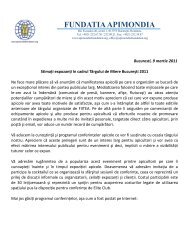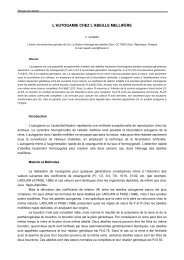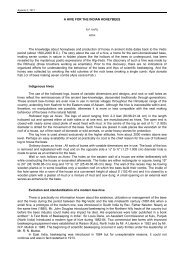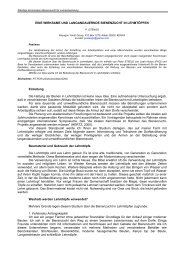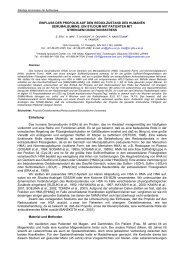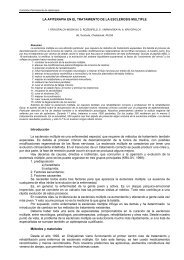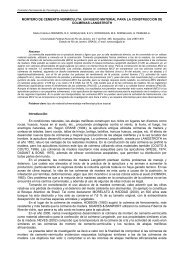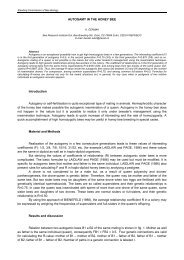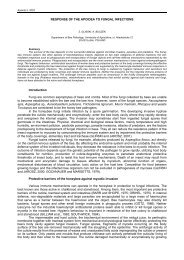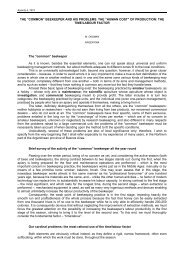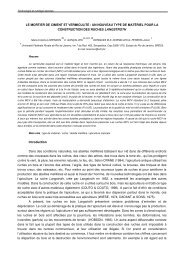control of american foulbrood by the shaking method - Apimondia
control of american foulbrood by the shaking method - Apimondia
control of american foulbrood by the shaking method - Apimondia
Create successful ePaper yourself
Turn your PDF publications into a flip-book with our unique Google optimized e-Paper software.
Apiacta 2, 2003<br />
CONTROL OF AMERICAN FOULBROOD BY THE SHAKING METHOD<br />
H. HANSEN, Camilla J. BRØDSGAARD<br />
Danish Institute <strong>of</strong> Agricultural Sciences, Research Group Entomology, Research Centre Flakkebjerg<br />
DK-4200 Slagelse, DENMARK<br />
Tel.: +45 58 11 34 31, Fax: +45 58 11 33 05, E-mail: henrik.hansen@agrsci.dk<br />
Abstract<br />
In a Danish apiary 15 bee colonies were fed honey containing 1.0x10 9 P.l. larvae spores and examined for two beekeeping<br />
seasons. 43 days after <strong>the</strong> spore feeding, 12 <strong>of</strong> <strong>the</strong> colonies showed clinical symptoms <strong>of</strong> American <strong>foulbrood</strong> (AFB). Only <strong>the</strong>se 12<br />
colonies were <strong>the</strong>n treated with <strong>the</strong> <strong>shaking</strong> <strong>method</strong>. After <strong>the</strong> <strong>shaking</strong> <strong>method</strong> was carried out a major reduction in <strong>the</strong> number <strong>of</strong><br />
spores in <strong>the</strong> honey <strong>of</strong> <strong>the</strong> treated colonies was seen. The number <strong>of</strong> spores were reduced to a level at which <strong>the</strong>y did not provoke<br />
fur<strong>the</strong>r clinical symptoms <strong>of</strong> AFB. Even though all colonies were fed <strong>the</strong> same number <strong>of</strong> spores 20% <strong>of</strong> <strong>the</strong> colonies never showed<br />
clinical symptoms. These colonies were able to reduce <strong>the</strong> number <strong>of</strong> spores in <strong>the</strong> honey within one season to a level that was equal to<br />
<strong>the</strong> treated colonies. In Denmark, <strong>the</strong> <strong>shaking</strong> <strong>method</strong> has been used successfully for <strong>the</strong> past 90 years.<br />
Key words: American <strong>foulbrood</strong> / Paenibacillus larvae larvae / <strong>shaking</strong> <strong>method</strong> / honey bees / Apis mellifera<br />
Introduction<br />
American <strong>foulbrood</strong> (AFB) is a serious disease <strong>of</strong> <strong>the</strong> honey bee brood. The disease is caused <strong>by</strong><br />
<strong>the</strong> spore-forming bacterium Paenibacillus larvae larvae [13] . The spores can survive for many years in scales,<br />
hive products and equipment [23] , and <strong>the</strong>y are very resistant to heat and chemicals [11] . Normally, colonies with<br />
clinical symptoms <strong>of</strong> AFB in capped brood cells will die if treatment is not carried out [9] .<br />
In many areas <strong>of</strong> <strong>the</strong> world, AFB is <strong>control</strong>led <strong>by</strong> antibiotics. However, residues <strong>of</strong> oxytetracyclin<br />
(OTC) have been found in honey from <strong>the</strong> brood nest <strong>of</strong> colonies fed antibiotic extender patties [21] .<br />
Fur<strong>the</strong>rmore strains <strong>of</strong> P.l. larvae may develop resistance to sulfathiazole and OTC under continuous use <strong>of</strong><br />
<strong>the</strong> drugs [17] and recently increasing problems with resistance <strong>of</strong> P.l. larvae to OTC have been reported [1,20] .<br />
OTC is also used in treatment <strong>of</strong> human bacterial infections, and thus this <strong>method</strong> <strong>of</strong> AFB <strong>control</strong> is not<br />
advisable. The use <strong>of</strong> <strong>the</strong>se antibiotics are <strong>the</strong>refore not registered for use on bees in Scandinavia and<br />
Germany.<br />
In Denmark, in order to <strong>control</strong> AFB without use <strong>of</strong> antibiotics, a variation <strong>of</strong> <strong>the</strong> <strong>shaking</strong> <strong>method</strong> has<br />
been used for <strong>the</strong> past 90 years [3] . Originally <strong>the</strong> <strong>shaking</strong> <strong>method</strong> was proposed <strong>by</strong> SCHIRACH in 1769 [22]<br />
and later rediscovered <strong>by</strong> McEVOY [14] . The <strong>method</strong> involves transferring <strong>the</strong> adult bees to a disease-free<br />
hive without drawn combs and destroying <strong>the</strong> brood combs <strong>of</strong> <strong>the</strong> infected colony. The contaminated honey<br />
in <strong>the</strong> honey stomach <strong>of</strong> <strong>the</strong> transferred bees is <strong>the</strong>n consumed while <strong>the</strong> bees build new combs.<br />
The bees can also be shaken into a screened box and kept <strong>the</strong>re for several hours at outdoor<br />
temperature [16] or a few days in a cool cellar [19] to ensure <strong>the</strong> consumption <strong>of</strong> <strong>the</strong> contaminated honey.<br />
Afterwards <strong>the</strong> bees are hived on frames with new foundation. In Denmark, <strong>the</strong> adult bees from colonies with<br />
clinical symptoms are shaken onto frames fitted with strips <strong>of</strong> wax. After 3 to 4 days, <strong>the</strong> bees are shaken<br />
onto frames with new foundation. Colonies in <strong>the</strong> apiary without clinical symptoms are not treated. If <strong>the</strong><br />
nectar flow is weak <strong>the</strong> colonies can be fed just after <strong>the</strong>y are shaken onto <strong>the</strong>se new foundation [10] .<br />
In 1998 and 1999, field experiments were carried out on a small Danish island. The aim <strong>of</strong> <strong>the</strong><br />
experiment was to elucidate <strong>the</strong> infection course in bee colonies in an apiary with clinical symptoms <strong>of</strong> AFB<br />
before and after treatment <strong>of</strong> <strong>the</strong> diseased colonies with <strong>the</strong> <strong>shaking</strong> <strong>method</strong>.<br />
Material and <strong>method</strong>s<br />
In early summer 1998, an apiary with a experimental group <strong>of</strong> 15 danish Apis mellifera ligustica bee<br />
colonies with inseminated queens <strong>of</strong> same origin were established. Each colony was inoculated <strong>by</strong> feeding<br />
100 g honey to which a sterile physiological saline solution containing 1.0x10 9 P.l. larvae spores was added.<br />
The spores originated from <strong>foulbrood</strong> scales <strong>of</strong> a Danish P.l. larvae strain (JT-79) [5] . The scales were<br />
supspended in sterile physiological saline, cultured, harvested, diluted, and counted as described <strong>by</strong><br />
BRØDSGAARD et al. [5] . The counts were repeated at least four times until <strong>the</strong> standard error not exceed 5%.<br />
The spore concentration in <strong>the</strong> dilution was calculated on <strong>the</strong> basis <strong>of</strong> <strong>the</strong> mean value <strong>of</strong> <strong>the</strong> counts.<br />
Fur<strong>the</strong>rmore, four uninfected bee colonies placed in ano<strong>the</strong>r apiary served as a <strong>control</strong> group.<br />
Before <strong>the</strong> inoculation honey samples were taken from each colony and examinated for P.l. larvae<br />
spores. The examination <strong>of</strong> <strong>the</strong> honey for P.l. larvae spores was done using direct inoculation on J-agar<br />
plates as described <strong>by</strong> HANSEN [8] with <strong>the</strong> modification that nine plates were used and <strong>the</strong> honey solution<br />
used contained 0.24 g honey per three plates. The detection level was 2,000 spores per g honey. After <strong>the</strong><br />
inoculation, honey samples were taken from each colony regularly and examined for P.l. larvae (totally 12<br />
samplings). At <strong>the</strong> days <strong>of</strong> sampling two to four honey samples were taken depending on <strong>the</strong> amount <strong>of</strong><br />
honey in <strong>the</strong> colonies. At each sampling, <strong>the</strong> colonies were also examined for clinical symptoms <strong>of</strong> AFB. The<br />
colonies were observed for two beekeeping seasons (16 months).
Apiacta 2, 2003<br />
At <strong>the</strong> third sampling, 43 days after <strong>the</strong> inoculation, 12 <strong>of</strong> <strong>the</strong> colonies in <strong>the</strong> experimental group<br />
showed clinical symptoms. Only <strong>the</strong>se 12 colonies were treated with <strong>the</strong> following modification <strong>of</strong> <strong>the</strong> <strong>shaking</strong><br />
<strong>method</strong>. The colonies were shaken onto frames fitted with strips <strong>of</strong> wax placed in decontaminated wooden<br />
boxes. The decontamination included scraping wax with a hive tool followed <strong>by</strong> treatment with Virkon® S<br />
which inactivates approximately 80% <strong>of</strong> <strong>the</strong> spores [2] . Queen excluders were placed under <strong>the</strong> boxes to<br />
prevent <strong>the</strong> colonies from swarming. The boxes were placed on bricks to allow <strong>the</strong> bees to fly. After 4 days,<br />
<strong>the</strong> bees were again shaken onto frames with new foundation in decontaminated boxes, and all colonies<br />
(including <strong>the</strong> three non-treated colonies) were fed with sugar.<br />
Results<br />
Before inoculation no contamination in <strong>the</strong> honey was found in any <strong>of</strong> <strong>the</strong> colonies.<br />
At <strong>the</strong> second sampling, <strong>the</strong> mean spore level in <strong>the</strong> honey was 3.5x10 6 ± 1.6x10 6 spores per g<br />
honey. In spite <strong>of</strong> <strong>the</strong> high spore levels none <strong>of</strong> <strong>the</strong> colonies showed clinical symptoms <strong>of</strong> AFB. At <strong>the</strong> third<br />
sampling, 43 days after <strong>the</strong> spore feeding, 12 <strong>of</strong> <strong>the</strong> colonies in <strong>the</strong> experimental groups showed clinical<br />
symptoms. The mean spore level in this group was <strong>the</strong>n 1.7x10 6 ± 5.1x10 5 spores per g honey. These 12<br />
colonies were treated with <strong>the</strong> <strong>shaking</strong> <strong>method</strong>. Though <strong>the</strong> spore level was equal to <strong>the</strong> colonies with<br />
clinical symptoms (Komogorov-Smirnov, P>0.05) <strong>the</strong> remaining three colonies did not show clinical<br />
symptoms at any <strong>of</strong> <strong>the</strong> samplings in <strong>the</strong> rest <strong>of</strong> <strong>the</strong> observation period ei<strong>the</strong>r and remained untreated.<br />
At <strong>the</strong> first sampling after <strong>the</strong> <strong>shaking</strong> procedure was carried out <strong>the</strong> spore level in <strong>the</strong> honey<br />
samples from <strong>the</strong> treated colonies were significantly reduced (WILCOXON, P0.05).<br />
The <strong>control</strong> colonies did not have detectable spore contents in <strong>the</strong> honey or show clinical symptoms<br />
at any sampling point in <strong>the</strong> observation period.<br />
Discussion<br />
The results <strong>of</strong> <strong>the</strong> present experiment with induced infection <strong>by</strong> inoculation show that even though all<br />
colonies were fed <strong>the</strong> same number <strong>of</strong> spores and spore levels in <strong>the</strong> honey reached <strong>the</strong> same high level<br />
20% <strong>of</strong> <strong>the</strong> colonies never showed clinical symptoms <strong>of</strong> AFB. Fur<strong>the</strong>rmore, <strong>the</strong>se colonies were able to<br />
reduce <strong>the</strong> number <strong>of</strong> spores in <strong>the</strong> honey to very low levels towards <strong>the</strong> end <strong>of</strong> <strong>the</strong> first season and clinical<br />
symptoms did not occur in <strong>the</strong> following season. This corresponds to earlier studies [9, 12] . Hence, even though<br />
<strong>the</strong> bees <strong>of</strong> <strong>the</strong> colonies in this experiment were very closely related a major difference in <strong>the</strong> ability to <strong>control</strong><br />
<strong>the</strong> disease was seen.<br />
Fur<strong>the</strong>rmore, <strong>the</strong> results shows that after <strong>the</strong> <strong>shaking</strong> <strong>method</strong> has been carried out, a major<br />
reduction in <strong>the</strong> number <strong>of</strong> spores in <strong>the</strong> treated colonies was seen. The spores were reduced to a level at<br />
which <strong>the</strong>y did not provoke fur<strong>the</strong>r clinical symptoms <strong>of</strong> AFB.<br />
On <strong>the</strong> basis <strong>of</strong> four samplings after <strong>the</strong> <strong>shaking</strong> <strong>method</strong> was carried out (one beekeeping season’s<br />
examination) OEHRING [18] states that not only does <strong>the</strong> <strong>shaking</strong> <strong>method</strong> <strong>control</strong> AFB but it also eliminates<br />
<strong>the</strong> spores from <strong>the</strong> colony. However, approx. 38% <strong>of</strong> <strong>the</strong> colonies in her experiment still had detectable<br />
spore levels at <strong>the</strong> end <strong>of</strong> <strong>the</strong> examination. This latter finding corresponds to our results showing that, though<br />
spore level was reduced significantly during <strong>the</strong> observation period, spores could still be detected at very low<br />
levels in <strong>the</strong> samples <strong>the</strong> following year. In addition, OEHRING’s conclusion that after <strong>the</strong> <strong>shaking</strong> <strong>method</strong><br />
was carried out <strong>the</strong> spores are eliminated to an extend where no clinical symptoms are found and <strong>the</strong> bee<br />
colonies are healthy corresponds to our findings.<br />
OEHRING [18] treated all <strong>the</strong> colonies <strong>by</strong> <strong>the</strong> <strong>shaking</strong> <strong>method</strong> if <strong>the</strong> spore level in <strong>the</strong> honey was high<br />
(whe<strong>the</strong>r or not <strong>the</strong>y showed clinical symptoms). We only treated <strong>the</strong> colonies showing clinical symptoms<br />
and our results indicate that even though <strong>the</strong> queens were closely related <strong>the</strong>re were still differences in<br />
tolerance against AFB. The colonies without clinical symptoms overcame <strong>the</strong> infection even though <strong>the</strong> spore<br />
levels in <strong>the</strong>se colonies were equal to <strong>the</strong> colonies showing clinical symptoms.<br />
After many years experience with statutory <strong>control</strong> <strong>of</strong> AFB in Denmark using <strong>the</strong> <strong>shaking</strong> <strong>method</strong>, it<br />
is our experience that this <strong>method</strong> is sufficient to <strong>control</strong> <strong>the</strong> disease providing that it is combined with hive<br />
decontamination [2] and comb melting from diseased colonies and store rooms. However, some Danish<br />
Buckfast strains recently have lost a part <strong>of</strong> <strong>the</strong>ir natural tolerance mechanisms against AFB, making <strong>the</strong>se<br />
strains are very sensitive to <strong>the</strong> disease [4] . Experience from <strong>the</strong> statutory <strong>control</strong> suggest that <strong>the</strong> <strong>shaking</strong><br />
<strong>method</strong> is not effective on <strong>the</strong>se strains because <strong>the</strong> <strong>method</strong> seems to fail in <strong>control</strong>ling AFB. Therefore,
Apiacta 2, 2003<br />
colonies <strong>of</strong> <strong>the</strong>se Buckfast strains are killed when <strong>the</strong>y have clinical symptoms <strong>of</strong> AFB. The results <strong>of</strong> <strong>the</strong><br />
present experiment indicates that all <strong>of</strong> <strong>the</strong> colonies from <strong>the</strong> tested bee strain do possess a certain degree<br />
<strong>of</strong> tolerance since no clinical symptoms or increase <strong>of</strong> spore levels in honey was seen <strong>the</strong> season following<br />
<strong>the</strong> treatment.<br />
It has been demonstrated that both <strong>shaking</strong> followed <strong>by</strong> a single treatment <strong>of</strong> oxytetracycline<br />
hydrochloride (OTC) and <strong>shaking</strong> without OTC are effective in eliminating AFB [7,15] . Consequently OTC<br />
treatment is not necessary. O<strong>the</strong>r authors [6, 7] also report that infected honey bee colonies treated only with<br />
<strong>the</strong> <strong>shaking</strong> <strong>method</strong> showed a significant reduction <strong>of</strong> <strong>the</strong> spore levels in honey, and in spite <strong>of</strong> <strong>the</strong> spores<br />
remaining in <strong>the</strong> colonies, no clinical symptoms were seen in <strong>the</strong> one season observation period. As shown<br />
also in our experiment, <strong>the</strong> <strong>shaking</strong> <strong>method</strong> will not eradicate all <strong>the</strong> <strong>foulbrood</strong> spores. Therefore, a<br />
precondition for an effective <strong>control</strong> using <strong>the</strong> <strong>shaking</strong> <strong>method</strong> may be that <strong>the</strong> treated bee colonies have a<br />
natural tolerance against American <strong>foulbrood</strong> e.g. larval resistance, hygienic behaviour and/or food inhibition<br />
<strong>of</strong> bacterial growth.<br />
The advantages <strong>of</strong> <strong>the</strong> <strong>shaking</strong> <strong>method</strong> are that it saves <strong>the</strong> bee colonies and that <strong>the</strong>re are no<br />
residues from drugs in honey and wax after <strong>the</strong> treatment. Ano<strong>the</strong>r reason why <strong>the</strong> <strong>shaking</strong> <strong>method</strong> is a<br />
viable <strong>control</strong> option is that strains <strong>of</strong> P.l. larvae has developed resistance to antibiotics. The disadvantages<br />
may be that <strong>the</strong> <strong>method</strong> is labour-intensive and a certain tolerance <strong>of</strong> <strong>the</strong> honey bees against AFB is<br />
necessary.<br />
Acknowledgement<br />
We thank L. HASMARK ANDERSEN and A. MARTHIN for <strong>the</strong>ir technical assistance.<br />
REFERENCES<br />
[1] Alippi A., Sensibilidad “in vitro” de Bacillus larvae frente a diferentes agentes antimicrobianos. Vida Apícola 66 (1994), 20-24<br />
[2] Brødsgaard C.J., Hansen H., Decontamination <strong>of</strong> beehives containing spores <strong>of</strong> <strong>the</strong> <strong>foulbrood</strong> bacterium Paenibacillus larvae<br />
larvae. Apiacta 34 (1999), 26-32<br />
[3] Broødsgaard C.J., Hansen H., Prevention and <strong>control</strong> <strong>of</strong> American <strong>foulbrood</strong> without use <strong>of</strong> antibiotics in: Proceedings <strong>of</strong> <strong>the</strong> XXXVI<br />
<strong>Apimondia</strong> Congress, Vancouver 1999, 47-48<br />
[4] Broødsgaard C.J., Hansen H., Testing <strong>of</strong> tolerance against AFB in honey bee larvae and colonies in: Proceedings <strong>of</strong> <strong>the</strong> 37 th<br />
<strong>Apimondia</strong> Congress, Durban, 2001, 5 pp<br />
[5] Broødsgaard C.J., Ritter W., Hansen H., Response <strong>of</strong> in vitro reared honey bee larvae to various doses <strong>of</strong> Paenibacillus larvae<br />
larvae spores. Apidologie 29 (1998), 1-10<br />
[6] Del Hoyo M.L., Basualdo M., Lorenzo A., Palacio M.A., Rodriguez E.M., Bedascarrasbure E., Effect <strong>of</strong> <strong>shaking</strong> honey bee colonies<br />
affected <strong>by</strong> American <strong>foulbrood</strong> on Paenibacillus larvae larvae spore loads. Journal <strong>of</strong> Apicultural Research 40 (2001), 65-69<br />
[7] Derakshifar I., Das Auftreten von Faulbrutsporen in österreichischen Honigen als diagnostische Methode zur Früherkennung von<br />
Faulbru<strong>the</strong>rden. Bienenvater 11 (1995), 464-469<br />
[8] Hansen H., The incidence <strong>of</strong> <strong>the</strong> <strong>foulbrood</strong> bacterium Bacillus larvae in honeys retailed in Denmark. Tidsskrift for Planteavl 88<br />
(1984), 329-336<br />
[9] Hansen H., Brødsgaard C.J., Der Verlauf der Amerikanishen (Bösartigen) Faulbrut in künstlich infizierten Völkern. Allgemeine<br />
Deutsche Imkerzeitung / die biene 3 (1997), 11-14<br />
[10] Hansen H., Rasmussen B., The investigation <strong>of</strong> honey from bee colonies for Bacillus larvae. Tidsskrift for Planteavl 90 (1986), 81-<br />
86<br />
[11] Hansen H., Rasmussen B., The sensitiveness <strong>of</strong> <strong>the</strong> <strong>foulbrood</strong> bacterium Bacillus larvae to heat treatment in: Proceedings <strong>of</strong> <strong>the</strong><br />
International Symposium on Recent Research on Bee Pathology, Gent, 1990, 146-148<br />
[12] Hansen H., Rasmussen B., Christensen F., Infection experiments with Bacillus larvae in: Proceedings <strong>of</strong> <strong>the</strong> XXXIInd International<br />
Apicultural Congress <strong>of</strong> <strong>Apimondia</strong>, Rio de Janeiro, 1989, <strong>Apimondia</strong> Publishing House, Bucharest, Romania, pp 207-212<br />
[13] Heyndrickx M., Vandemeulebroeske K., Hoste B., Janssen P., Kersters K., De Vois P., Logan N.A., Ali N., Berkeley R.C.W.,<br />
Reclassification <strong>of</strong> Paenibacillus (formerly Bacillus) pulvifaciens (Nakamura 1984) Ash et al., 1994, a Later Subjective Synonym <strong>of</strong><br />
Paenibacillus (formerly Bacillus) larvae (White 1906) Ash et al., 1994, as a Subspecies <strong>of</strong> P. larvae, with Emended Description <strong>of</strong> P.<br />
larvae as P. larvae subsp. larvae and P. larvae subsp. pulvifaciens. International Journal <strong>of</strong> Systematic Bacteriology 46 (1996), 270-<br />
279<br />
[14] Howard L.O., Report <strong>of</strong> <strong>the</strong> meeting <strong>of</strong> inspectors <strong>of</strong> apiaries, San Antonio, Texas, November 1906. USDA, Bureau <strong>of</strong> Entomology,<br />
Bulletin 70 (1970)<br />
[15] Knox D.A., Shimanuki H., Caron D.M., Ethylene oxide plus oxytetracycline for <strong>the</strong> <strong>control</strong> <strong>of</strong> American <strong>foulbrood</strong> in honey bees.<br />
Journal <strong>of</strong> Economic Entomology 69 (1976), 606-608<br />
[16] Ma<strong>the</strong>son A., Strategies for prevention and <strong>control</strong> <strong>of</strong> American <strong>foulbrood</strong>. American Bee Journal 132 (1992), 399-402, 471-475,<br />
534-537, 547<br />
[17] Morse R., Shimanuki H., Summary <strong>of</strong> <strong>control</strong> <strong>method</strong>s. In: (Ed. Morse, R.A.,) Honey Bee, Pests, Predators and Diseases. Cornell<br />
University Press, Ithaca, 1990, 342-361<br />
[18] Oehring M., Bakteriologische Überprüfung von Sanierungsmaßnahmen im Rahmen der Bekämpfung der Amerikanischen Faulbrut.<br />
Inaugural-Dissertation zur Erlangung des Grades eines Doctor Medicinae Veterinariae durch der Tierärtzliche Hochschule<br />
Hannover, 1998, 169 pp<br />
[19] Ritter W., Diagnostik und Bekämpfung der Bienenkrankheiten. Gustav Fischer Verlag, Jena, 1996, 230 pp<br />
[20] Spivak M., Gilliam M., Hygienic behaviour <strong>of</strong> honey bees and its application for <strong>control</strong> <strong>of</strong> brood diseases and varroa. Part I.<br />
Hygienic behaviour and resistance to American <strong>foulbrood</strong>. Bee World 79 (1998), 124-134<br />
[21] Wilson W.T., Residues <strong>of</strong> oxytetracycline in honey stored <strong>by</strong> Apis mellifera. Environmental Entomology 3 (1974), 674-676<br />
[22] White G.F., The bacteria <strong>of</strong> <strong>the</strong> apiary with special reference to bee disease. US Department <strong>of</strong> Agriculture, Bureau <strong>of</strong> Entomology,<br />
Technical Series, No. 14 (1906), 50 pp<br />
[23] White G.F., American <strong>foulbrood</strong>. US Department <strong>of</strong> Agriculture, Bureau <strong>of</strong> Entomology, Bulletin 809 (1920), 54 pp




